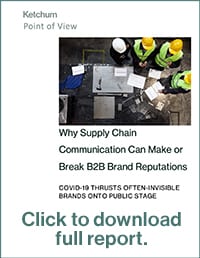What ingredients go into the food we eat? What materials are in a beauty product? What software tools help a brand interact online, and what environmental impact does a given material have? For any B2B brand that provides the individual elements behind a consumer facing product, the need for transparency with consumers has been growing for years—and COVID-19 has accelerated this trend.
As supply chain disruption in many products causes consumer frustration and public alarm, the spotlight is on B2B suppliers to tell the story of why goods and services are not reaching the people who rely on them. And B2B companies’ own customers are beginning to demand more support from their partners in communicating with the public.

B2B brands need to get serious about inside-out communication to consumers, or else risk a backlash from regulators, investors, local communities and customers. We’ve identified several key communication considerations for B2B brands with supply chain challenges.
- Don’t Assume. It’s unlikely that consumers understand the basics about your supply chain, or the challenges it faces. Start with a commitment to meet your audience where they live, rather than taking anything for granted.
- Test and Benchmark. The best way to know what people do understand is through research—a data-based approach will point the direction to the story you need to build.
- Show, Don’t Tell. Transparency is the key to true understanding, particularly when it comes to manufacturing, industrial processes or logistics. Use video, graphics, employee testimonials and more to help people actually see firsthand what you’re trying to explain.
- Address the Right Audience. Communicating to your local communities is different from communicating with your B2B customers. Tailor a distinct approach to the differing needs of these audiences to avoid charges of insensitivity, or worse.
- Demonstrate Urgency (if You Can). With much of the world still in wait-and-see mode, an advantage goes to businesses who can seize the moment with speed and agility.
- Brace Yourself for Conflicting Priorities. In the new reality, supply chain issues have the potential to clash with sustainability goals. Prepare for this proactively by reevaluating those goals, updating your positions and managing the expectations of your customers and the broader public.
- Prepare for Political Backlash. In the current environment, any company, process or story is at risk of being politicized. Assess your vulnerabilities and have a response plan in place.
- Protect your People. The way you treat your employees, especially those at the front line of your business, will be remembered. Your communications impact your chance of being an employer of choice, both now and in the future.
 Our world is more interdependent than ever, and keeping these points in mind will help orient you to the often diverging needs of your partners, your employees, your communities, your customers and the world at large.
Our world is more interdependent than ever, and keeping these points in mind will help orient you to the often diverging needs of your partners, your employees, your communities, your customers and the world at large.
For more detail on these points, see this short report highlighting the triggers that B2B brands need to pay attention to when creating a COVID-19 recovering and rebound communication strategy. If you’d like to talk more about how Ketchum can help your company face these and similar challenges, don’t hesitate to get in touch.


